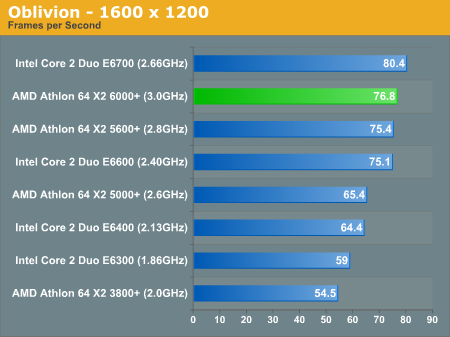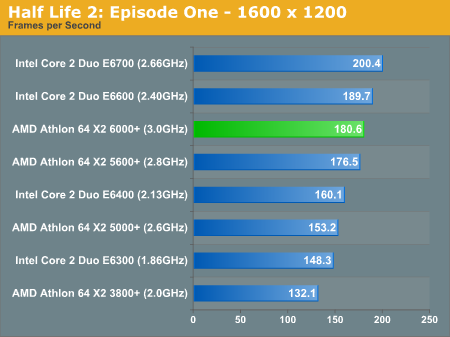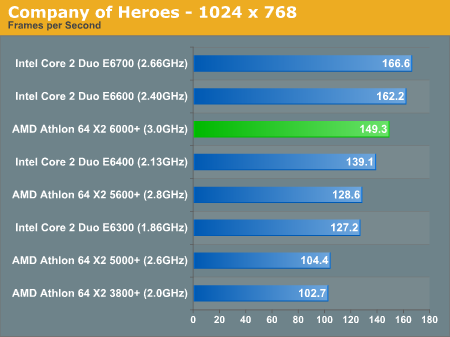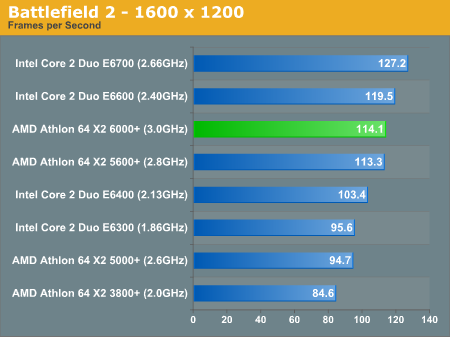AMD Athlon 64 X2 6000+: Competing with Aggressive Pricing
by Anand Lal Shimpi on February 20, 2007 3:37 PM EST- Posted in
- CPUs
Gaming Performance
Given that we were running under Windows Vista, we only focused on DirectX gaming performance due to the current state of OpenGL performance in the new OS. All of our game benchmarks are 32-bit.
First up is Oblivion, where we benchmarked a timed FRAPS run through of a savegame within the Bruma town gates. Oblivion has just as many CPU bound situations as it does GPU bound situations, this benchmark is merely one of the CPU bound cases. We tested Oblivion with the 1.1 patch and the game's default Very High quality settings, which can still be CPU bound with an 8800 GTX at 1600 x 1200:

Oblivion performance is actually pretty close between the two processor families. Although the E6700 is a bit faster than the X2 6000+, the 5600+ offers the same performance as the E6600. And the X2 5000+ is virtually tied with the E6400 - you can't go wrong with either processor here.
We measured performance in Half Life 2: Episode One using a custom recorded timedemo, the same benchmark we've used in previous reviews. All quality settings were set to their highest values except for AA and AF which remained disabled.

Half Life 2 has been a bit more at home with Intel's Core 2 architecture than AMD's Athlon 64 X2, although both CPUs are more than fast enough to run the game Intel is technically faster at the sort of calculations that the Source engine requires of a CPU.
Company of Heroes is a RTS by Relic and actually makes good use of multi-core CPUs. All of the games quality settings were set to their highest values, except for AA which was disabled. We tested at 1024 x 768 in order to run at a more CPU bound configuration. We benchmarked the game with its 1.04 patch, using its built-in performance test and reported average frame rate:

CoH gave us some very odd results, seemingly favoring larger L2 caches over increases in clock speed. Intel manages to take the lead here as well.
Finally we have Battlefield 2 performance, using in game High quality settings and the same benchmark we've used in previous reviews:

Battlefield 2 echoes what we've seen elsewhere, although the Intel performance advantage has shrunk to only 11% in the case of the E6700 vs. 6000+.










34 Comments
View All Comments
defter - Wednesday, February 21, 2007 - link
The maximum measured 8800GTX power consumption is about 150W. NVidia has mentioned that absolute maximum is 180W. However, since this is a CPU review, it's logical to assume that they stressed only the CPU in "full load" power consumption test.poohbear - Wednesday, February 21, 2007 - link
wow so 260w load plus 50w for a 8800gtx, thats only 310wts! kinda strange when companies are selling 1kilowatt psus.:/poohbear - Tuesday, February 20, 2007 - link
i was gonna ask the exact same question. I wish they'd clarify that in the articles when they talk about power consumption. Is that 263wts under load for the 5600+ JUST for the cpu or the whole system? thanks for any of the writers who can clarify this 100%.JarredWalton - Tuesday, February 20, 2007 - link
Power reports are always for the entire system. Obviously, lower end GPUs would reduce total power requirements quite a bit, but in maximum load testing the stress is only on the CPU and not the GPU. Thus, the ~50W power difference is going to remain whether you're running an 8800 GTX or an X1300 SE. The latter would simply use probably 40-50W less total power.bamacre - Tuesday, February 20, 2007 - link
Add in OC'ing and Intel, still, jumps further in the lead.BladeVenom - Tuesday, February 20, 2007 - link
But most people don't overclock.ViRGE - Tuesday, February 20, 2007 - link
Many of the readers of this site do though. The C2D is so mind numbingly easy to overclock, it's hard to not do it.Roy2001 - Tuesday, February 20, 2007 - link
I agree. I never OCed before. But with E6400 it is so easy. I just changed FSB from 266 to 350, I have a 2.8Ghz C2D. No voltage change, no cooling change. That's easy.mino - Tuesday, February 20, 2007 - link
Not to mention 800FSB E4300 parts.2.66/333FSB is pretty much a safe bet on most boards.
Even 2.13 for $150 is nice with board at STOCK FSB!.
Who needs E6400 then :) (for stock performance).
poohbear - Tuesday, February 20, 2007 - link
well if a 2.4ghz C2D can beat a AMD64 @ 3.0ghz, then calling a C2D @ 3.2ghz (the average overclock from what im reading) the "king" processor is a monumental understatement. It'd rape the 6000+.